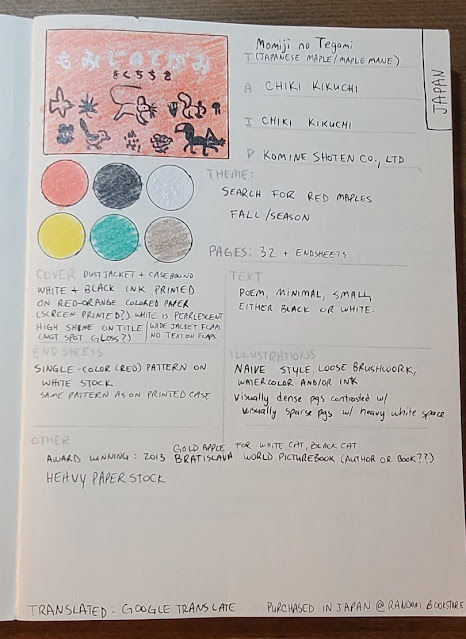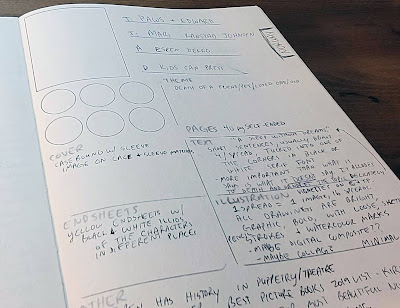Master Studies.
As artists, I think most of us have heard the term “master studies” used to train and develop budding artists in different mediums. For those who don’t know, the concept is going to a museum (or studying a high resolution reproduction/digital image) and trying to recreate a painting of a historical artist who was well into their established technique--a master of their painting style. We can learn different things from doing this: composition, color palette, how to use color and dark/light to focus the eye, how they apply the paint, etc. In some museums, there would be days where you could set up your canvas IN the museum and paint/recreate the artwork en plein air.
But how does one do a master study of picture books? I decided to try and find out.
Here’s a selection of sources that I have or will source names of authors/illustrators from:
ALSC’s Mildred L. Batchelder Award - Award given in the United States for books originating from another country, often translated into English for publication within the U.S.
IBBY’s Bookbird: A Journal of International Children’s Literature - At least one issue a year focused on award winners, with a section on illustrators.
IBBY’s Hans Christian Anderson Award: every year a selection of both authors and illustrators are shortlisted for this award and a wider list of creators are nominated for
China Shanghai International Children’s Book Fair's Chen Bochui International Children’s Literature Award
DPictus Picturebook Makers blog - Interviews with various international picture book creators plus a curated section of their website
Frankfurt Book Fair/DPictus Unpublished Picturebook Showcase - this has a list of some of the top international publishers and if you go to the individual publisher’s websites, you can see which of their titles are most prominent/most marketed.
Picturebook Museum - this is a recent discovery a friend made of a Korean site that shares a number of amazing spreads from international picture books (each book includes a flag image of country of origin). I don’t know what the parameters are for the books that appear on this website, but it’s a beautiful site to get lost in.
Enchanted Lion Books - this United States publisher gets a special callout because they focus on translations of international books and all their books are beautiful.
Second, build a list. You will probably grow your list faster than you are able to research/read books created by these authors or artists. I have a Google Keep list I started to specifically track award-winning international illustrators.
Third, research. This takes a lot of time, but can also be a lot of fun when you go down the rabbit hole. The type of research also comes in multiple forms. When I find an artist I want to study, I first go and see which of their titles are available to be checked out through my local library. Alternatively, if you want to own the books you study, you can see what is available for purchase in your country by that creator. I also try to research the artist online, reading wikipedia entries, interviews, and occasionally stumbling upon a video about the artist and their creations, such as this interview with Satoe Tone.
Fourth, acquire your source material to study. I usually try to check out 2-3 books from an artist if they are available to get a sense of the type of books the author/illustrator creates and just in case the book(s) they are known for are illustrated books that do not fall within my self-determined parameters of “picture book.” I decided that I would focus on books that fell within the parameters of a traditional/classic picture book: larger format with minimal words; approximately 32-48 pages, occasionally slightly longer; not a graphic novel/comic book format; not a board book aimed towards the youngest age range (0-2 years); not a chapter book with illustrations.
Fifth, study your source material. Read. Read it again. And again. Study it. Thoroughly. This stage loops back to how you define your original parameters: WHAT are you studying within this book? HOW are you tracking what you are studying?
I originally defined my research project as studying “international picture books” and then my coworker sent me a digital picture book from India. I read it, it was a beautiful book, but in doing so, I realized there was something missing in this book: what I REALLY wanted to study was “international picture books in their tangible, printed format.” I was curious about the decisions on trim size, paper stock, binding types, typefaces and sizes, color palettes, special finishes, and the physical page turn effect of the book. You know, all the geeky, design-oriented decisions that were made in producing the physical product that is a picture book. Just the thing that this geeky graphic designer and illustrator loves.
I began to document my research in what will probably be my one-and-only meticulously organized sketchbook. I wanted each book study to fill a single page and I broke down my categories to fill in on each page as follows:
Sketch of cover art
Color palette: what 6(ish) colors were the most dominant in this book?
Title: In both original language and English, if possible
Author: Who wrote the book?
Illustrator: who illustrated the book? Is this the same as the author?
Publisher(s): more than one if it’s a translation; you can often find the original publisher name on the copyright page
Country/Countries: Where did this book originate and/or where was this creator from and/or where was this translation from? Sometimes they are not the same.
Theme: VERY brief summary of what the book is about
Pages: length of book
Cover: is there a dust jacket? Is there a printed illustration on the case bound books that differs from the dust jacket? Special finishes?
Endsheets: Are these just plain pages of a contrasting color/stock? Are there illustrations on the endsheets that expand on the story?
Text: font choice(s)? Font size? Font color? specific/repeating placement on the pages? Are the lines of text broken into poetic stanzas? Are there varying sizes/colors/fonts to emphasize or represent different things?
Illustrations: what materials do they use? Is there a recurring pattern to how the illustrations are presented? How many are double-page spreads, single pages, vignettes?
Other: a little information about the artist or awards this book won
Translation format: If not printed in English, I typically used Google Translate to comprehend the text well enough to get a sense of the book as a whole. While there is definitely an elegance of words and cadence lost in translation, my primary focus is from the visual/artistic standpoint of the book including how the text VISUALLY appears on a page.
Origin of book: usually checked out from LAPL, but occasionally a purchased title
*** WARNING: May contain spoilers ***
In some ways this is a failed project. This started out as an exploration of research in preparation for a presentation for an artist residency in Iceland that was supposed to happen in 2020. I started my research in September of 2019, requesting and checking picture books out of my local library in the Los Angeles Public Library system, which has a surprisingly wide selection of international picture books (or translations of international picture books) available. And then March 2020 happened and the world shut down. Libraries closed. My research came to a screeching halt. I will pick it up again at some point because while it was time consuming, I also loved the research. But in other ways this is the start of a resounding success. I have filled in or partially filled in notes for 13 picture books. This is not a large enough quantitative sampling to establish any sort of baseline conclusion regarding the relationship of type of book or theme or color palette with specific countries in the world, or to even begin to reflect on their population's likes and dislikes. If I were to analyze one picture book like this every day, I would still not even begin to delve into the quantity of picture books published worldwide in a single year. And yet. Yet I feel that even studying these few books leads me to make some conclusions: a lot of thought, skill, craft, wit, and intent goes into each and every book created. They are all incredible works of art regardless of style, theme, or art technique. They are all glorious, magnificent creations and, naturally, I want to add MY glorious, magnificent creations to the world to join them. They all inspire. Now it's time to go find your own Master Studies to use as inspirations and then go create YOUR creations.
 |
| © Cole Montgomery |
More about Gail at her website, instagram, twitter, and facebook.















No comments:
Post a Comment